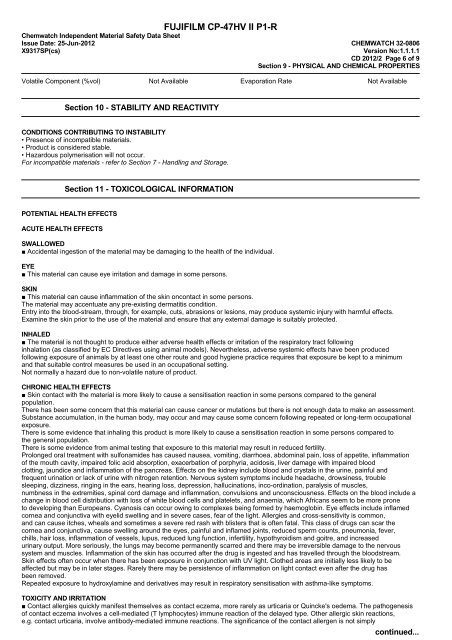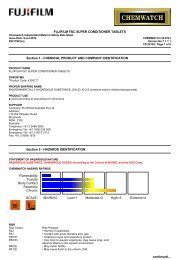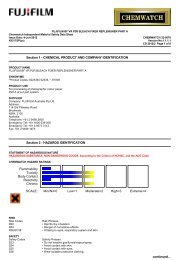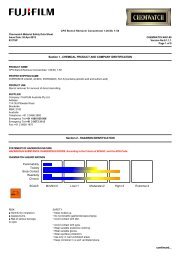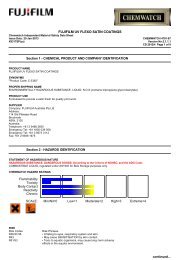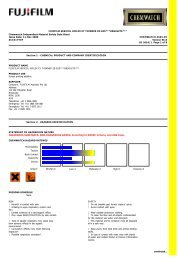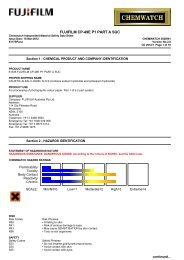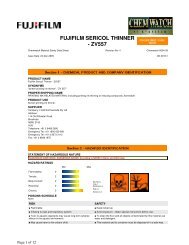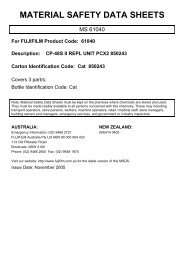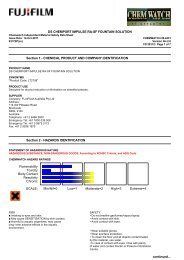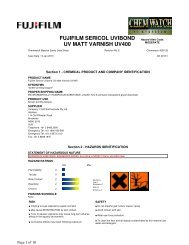Chemwatch Australian MSDS 32-0806 - FUJIFILM Australia
Chemwatch Australian MSDS 32-0806 - FUJIFILM Australia
Chemwatch Australian MSDS 32-0806 - FUJIFILM Australia
Create successful ePaper yourself
Turn your PDF publications into a flip-book with our unique Google optimized e-Paper software.
<strong>FUJIFILM</strong> CP-47HV II P1-R<strong>Chemwatch</strong> Independent Material Safety Data SheetIssue Date: 25-Jun-2012 CHEMWATCH <strong>32</strong>-<strong>0806</strong>X9317SP(cs)Version No:1.1.1.1CD 2012/2 Page 6 of 9Section 9 - PHYSICAL AND CHEMICAL PROPERTIESVolatile Component (%vol) Not Available Evaporation Rate Not AvailableSection 10 - STABILITY AND REACTIVITYCONDITIONS CONTRIBUTING TO INSTABILITY• Presence of incompatible materials.• Product is considered stable.• Hazardous polymerisation will not occur.For incompatible materials - refer to Section 7 - Handling and Storage.Section 11 - TOXICOLOGICAL INFORMATIONPOTENTIAL HEALTH EFFECTSACUTE HEALTH EFFECTSSWALLOWED■ Accidental ingestion of the material may be damaging to the health of the individual.EYE■ This material can cause eye irritation and damage in some persons.SKIN■ This material can cause inflammation of the skin oncontact in some persons.The material may accentuate any pre-existing dermatitis condition.Entry into the blood-stream, through, for example, cuts, abrasions or lesions, may produce systemic injury with harmful effects.Examine the skin prior to the use of the material and ensure that any external damage is suitably protected.INHALED■ The material is not thought to produce either adverse health effects or irritation of the respiratory tract followinginhalation (as classified by EC Directives using animal models). Nevertheless, adverse systemic effects have been producedfollowing exposure of animals by at least one other route and good hygiene practice requires that exposure be kept to a minimumand that suitable control measures be used in an occupational setting.Not normally a hazard due to non-volatile nature of product.CHRONIC HEALTH EFFECTS■ Skin contact with the material is more likely to cause a sensitisation reaction in some persons compared to the generalpopulation.There has been some concern that this material can cause cancer or mutations but there is not enough data to make an assessment.Substance accumulation, in the human body, may occur and may cause some concern following repeated or long-term occupationalexposure.There is some evidence that inhaling this product is more likely to cause a sensitisation reaction in some persons compared tothe general population.There is some evidence from animal testing that exposure to this material may result in reduced fertility.Prolonged oral treatment with sulfonamides has caused nausea, vomiting, diarrhoea, abdominal pain, loss of appetite, inflammationof the mouth cavity, impaired folic acid absorption, exacerbation of porphyria, acidosis, liver damage with impaired bloodclotting, jaundice and inflammation of the pancreas. Effects on the kidney include blood and crystals in the urine, painful andfrequent urination or lack of urine with nitrogen retention. Nervous system symptoms include headache, drowsiness, troublesleeping, dizziness, ringing in the ears, hearing loss, depression, hallucinations, inco-ordination, paralysis of muscles,numbness in the extremities, spinal cord damage and inflammation, convulsions and unconsciousness. Effects on the blood include achange in blood cell distribution with loss of white blood cells and platelets, and anaemia, which Africans seem to be more proneto developing than Europeans. Cyanosis can occur owing to complexes being formed by haemoglobin. Eye effects include inflamedcornea and conjunctiva with eyelid swelling and in severe cases, fear of the light. Allergies and cross-sensitivity is common,and can cause itches, wheals and sometimes a severe red rash with blisters that is often fatal. This class of drugs can scar thecornea and conjunctiva, cause swelling around the eyes, painful and inflamed joints, reduced sperm counts, pneumonia, fever,chills, hair loss, inflammation of vessels, lupus, reduced lung function, infertility, hypothyroidism and goitre, and increasedurinary output. More seriously, the lungs may become permanently scarred and there may be irreversible damage to the nervoussystem and muscles. Inflammation of the skin has occurred after the drug is ingested and has travelled through the bloodstream.Skin effects often occur when there has been exposure in conjunction with UV light. Clothed areas are initially less likely to beaffected but may be in later stages. Rarely there may be persistence of inflammation on light contact even after the drug hasbeen removed.Repeated exposure to hydroxylamine and derivatives may result in respiratory sensitisation with asthma-like symptoms.TOXICITY AND IRRITATION■ Contact allergies quickly manifest themselves as contact eczema, more rarely as urticaria or Quincke's oedema. The pathogenesisof contact eczema involves a cell-mediated (T lymphocytes) immune reaction of the delayed type. Other allergic skin reactions,e.g. contact urticaria, involve antibody-mediated immune reactions. The significance of the contact allergen is not simplycontinued...


